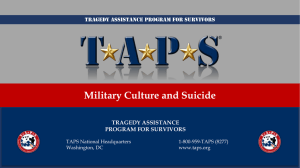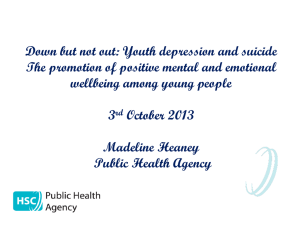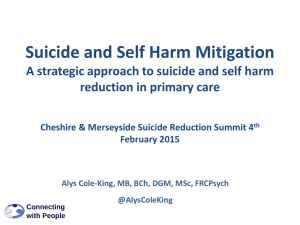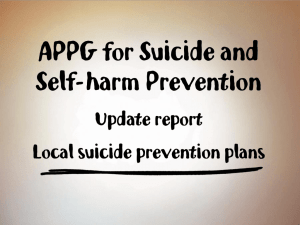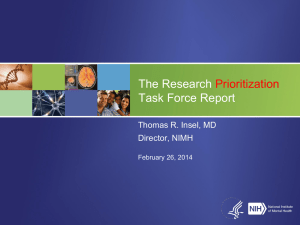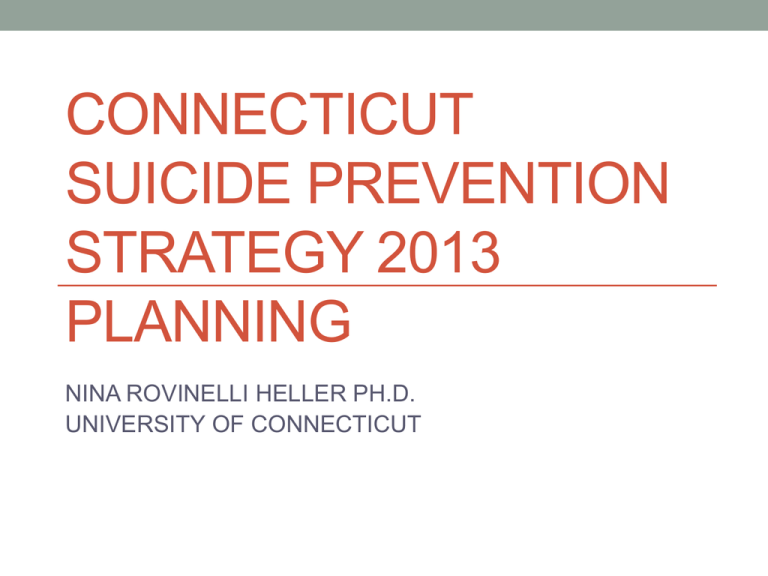
CONNECTICUT
SUICIDE PREVENTION
STRATEGY 2013
PLANNING
NINA ROVINELLI HELLER PH.D.
UNIVERSITY OF CONNECTICUT
AREAS FOR CONSIDERATION
1. THE NATIONAL SUICIDE PREVENTION STRATEGY
2.
3.
4.
5.
6.
7.
2012
SAMHSA GUIDELINES FOR STATE SUICIDE
PREVENTION LEADERSHIP AND PLANS
EXEMPLARS FROM OTHER STATES
OVERVIEW OF 2005 CT SUICIDE PREVENTION
PLAN
PRELIMINARY AREAS FOR FOCUS FOR 2013 CT
PLAN
PROCEDURAL ISSUES
DISCUSSION
1. 2012 NATIONAL STRATEGY
HIGHLIGHTS
• 10 YEAR PLAN
• 13 GOALS AND 60 OBJECTIVES
• MAJOR DEVELOPMENTS IN THIS UPDATE:
• RELATIONSHIP BETWEEN SUICIDE AND MENTAL ILLNESS,
SUBSTANCE ABUSE, TRAUMA, VIOLENCE, AND RELATED
ISSUES.
• NEW INFORMATION ON GROUPS THAT MAY BE AT ELEVATED
RISK FOR SUICIDAL BEHAVIORS
• INCREASED KNOWLEDGE OF TYPES OF EFFECTIVE
INTERVENTIONS;
• INCREASE RECOGNITION OF IMPORTANT OF
COMPREHENSIVE AND COORDINATED EFFORTS
NAT’L CONT’D
• COMPREHENSIVE APPROACH MUST INCLUDE:
• COMMUNITY, FAMILY, LEVEL
• PRIMARY CARE AND EMERGENCY DEPARTMENTS
• COMMUNITY WHILE RECEIVING CARE
• COMMUNITY AFTER RECOVERY
DOCUMENTS THAT INFORMED
NATIONAL STRATEGY
• National Prevention Strategy, National Prevention, Health
•
•
•
•
•
•
Promotion and Public Health Council, 2011
HealthyPeople 2020, U.S. Department of Health and
Human Services
Charting the Future of Suicide Prevention, SPRCm abd
SPAN USA
Preventing Mental, Emotional and Behavioral Disorders
Among Young People: Progress and Possibilities, 2009
Reducing Suicide: A National Imperative;
World Report on Violence and Health, WHO, 2002
Prevention of Suicide: Guidelines for the Formulation and
Implementation of National Strategies, UN, 1996
Organization of National Strategy
Directions
• Healthy and empowered individuals, families and
communities;
• Clinical and Community preventive services;
• Treatment and support services;
• Surveillance, research and evaluation.
THEMES SHARED ACROSS DIRECTIONS:
• Foster positive public dialogue;
THEMES SHARED ACROSS
DIRECTIONS:
• Foster positive public dialogue;
• Address needs of vulnerable groups, eliminate disparities;
• Be coordinated and integrated with existing health and
•
•
•
•
behavioral health systems;
Promote changes in systems, policies that will support
prevention;
Bring together public health and behavioral health;
Promoted efforts to reduce access to lethal means among
those with identified risk;
Apply the most up to date knowledge
13 Goals National Strategy
Strategic Direction # 1 – Healthy individuals, families,
communities
1. Integrate prevention efforts across sectors and settings;
2. Implement research-informed communication efforts for
prevention by changing knowledge, attitudes and
behaviors;
3.Increase knowledge of factors offering protection and that
promote wellness and recovery;
4. Promoted responsible media reporting, accurate
portrayals in entertainment, and safety of online content.
Strategic direction #2:
Clinical and Community Prevention Goals
5. Develop, implement, monitor effective programs that
promote wellness and prevent suicide and related
behaviors;
6. Promote efforts to reduce access to lethal means of
suicide among individuals with identified risk;
7. Provide training to community and clinical service
providers on prevention of suicide and related behaviors;
Strategic Direction #3 – Treatment and
Support Services
8. Promote suicide prevention as a core component of
health care services;
9. Promote and implement effective clinical and
professional practices for assessing and treating those
identified as being at risk for suicidal behaviors;
10. Provide care and support to individuals affected by
suicide and attempts to promote healing and implement
community strategies to help prevent further suicides;
Strategic Direction #4 – Surveillance,
Research, and Evaluation Goals
11. Increase timeliness and usefulness of [state]
surveillance systems and improve ability to collect, analyze,
and use this information;
12. Promote and support research on suicide prevention;
13. Evaluate the impact and effectiveness of suicide
prevention interventions and systems and synthesize and
disseminate findings.
From the National to the State – SAMHSA
SUGGESTS:
Behavioral Health agencies play a leadership role.
Key Plan Elements and Characteristics. Plans should be:
1. data driven, while strategies can be flexible [Delaware]
2. comprehensive, but set priorities [Massachusetts]
3. incorporate a collaborative effort by multiple public
and private organizations, while focusing on what
can be done first [naasp/clinical care]
4. clinically informed, but based on the public health
approach; [North Carolina]
SAMHSA RECOMMENDATIONS, con’t
5. focus on a lifespan approach [Wisconsin]
6. utilize research and safety informed
communications [Oregon]
7. promote accountability and be regularly
monitored, updated, and revised [Nebraska].
Connecticut Suicide Prevention Plan
2005
Addressed the following goals:
1. Reduce the suicide rate
2. Reduce suicide attempts
3. Increase the number of persons in primary health care
who receive mental health screening and assessment
4. Increase the proportion of children with mental health
problems who receive treatment
5. Increase the proportion of juvenile justice facilities that
screen clients for mental health problems.
CT 2005 Five categories for
recommendations
1. Life span or overarching
prevention strategies, access to quality mental
health care, enhance data collection, surveillance,
research, etc. [many of these are repeated and
expanded in sections below]
2. Children and Youth – Birth through 19
3. Adults 20-64
4. Elders – 65+
5. Criminal Justice System, all ages.
Then and Now
• Suicide Advisory Board is a much broader coalition than
the previous Interagency Suicide Prevention Network,
representing a wide mix of public state agencies, private
not for profits, professions, survivors, veterans, military,
clergy, schools, universities, health care agencies, police,
and communities.
• Preliminary thoughts:
• Need for greater focus on ethnic, racial, cultural differences,
• Clear plan for monitoring and evaluating ongoing progress on the
goals and objectives
• Structure for managing the “moving targets” of groups at risk
• Increased focus upon suicidal intent and related behaviors.
OUR TASKS:
DEVELOP PRIORITY
• GOALS
• POPULATIONS
• SETTINGS
PLAN:
• REVIEW OF LATEST DATA; [SMALL WORKGROUP]
• DEVELOPMENT OF OF SURVEY DOCUMENT WITH
STRUCTURE PARALLEL TO NATIONAL STRATEGY
• DISSEMINATION OF SURVEY VIA SURVEY MONKEY
TO DEVELOP CONNECTICUT PRIORITIES
• REPORT BACK ON RESULTS (NH)
OUR TASKS, con’t
• Full group review of results; development of small group
teams to work on each priority section.
• Writing tasks.





